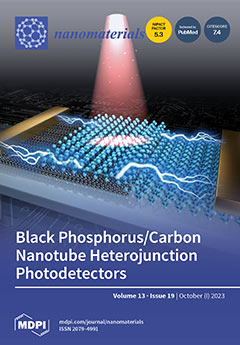This work describes a resonance Raman study performed in the domes of monolayer MoS
2 using 23 different laser excitation energies covering the visible and near-infrared (NIR) ranges. The multiple excitation results allowed us to investigate the exciton–phonon interactions of different phonons (A
[...] Read more.
This work describes a resonance Raman study performed in the domes of monolayer MoS
2 using 23 different laser excitation energies covering the visible and near-infrared (NIR) ranges. The multiple excitation results allowed us to investigate the exciton–phonon interactions of different phonons (A
1, E
, and LA) with different excitonic optical transitions in biaxially strained monolayer MoS
. The analysis of the intensities of the two first-order peaks, A
1 and E
, and the double-resonance 2LA Raman band as a function of the laser excitation furnished the values of the energies of the indirect exciton and the direct excitonic transitions in the strained MoS
domes. It was noticed that the out-of-plane A
1 phonon mode is significantly enhanced only by the indirect exciton I and the C exciton, whereas the in-plane E
mode is only enhanced by the C exciton of the MoS
2 dome, thus revealing the weak interaction of these phonons with the A and B excitons in the strained MoS
domes. On the other hand, the 2LA Raman band is significantly enhanced at the indirect exciton I and by the A (or B) exciton but not enhanced by the C exciton, thus showing that the LA edge phonons that participate in the double-resonance process in MoS
have a weak interaction with the C exciton.
Full article






